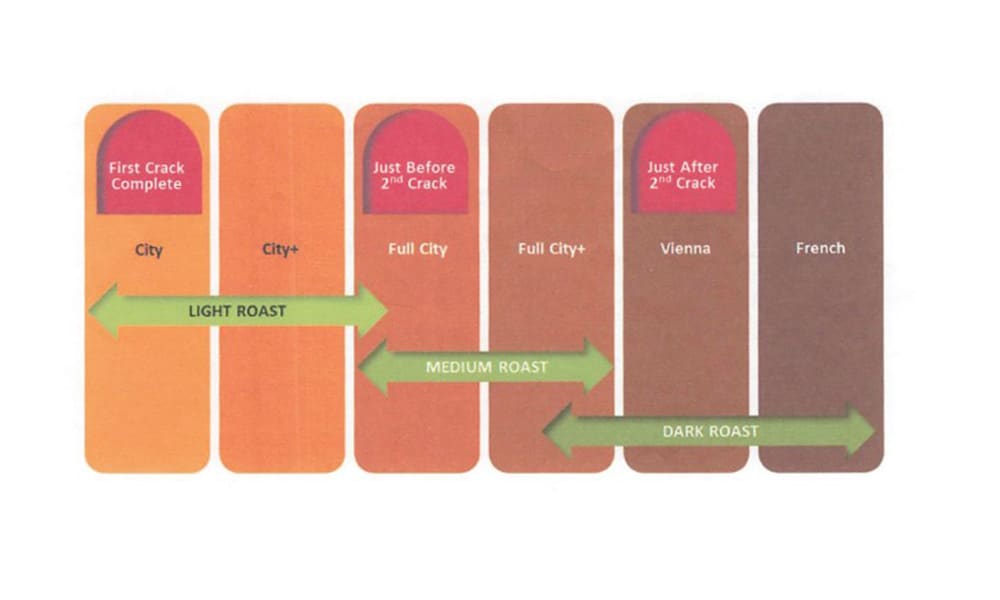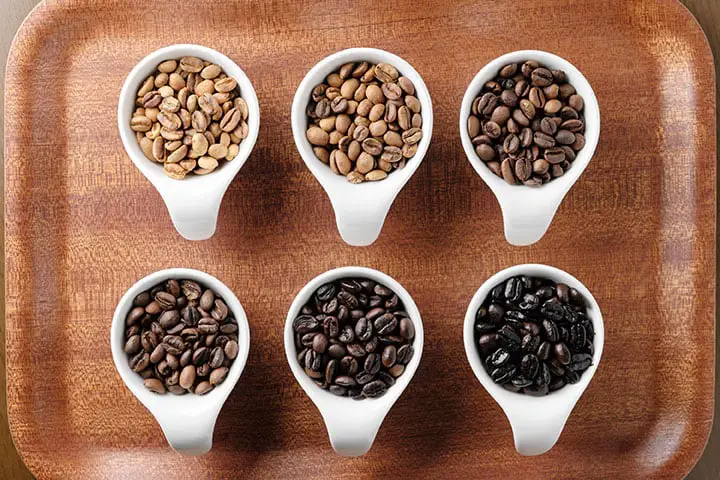
Start on the exciting journey of discovering the ideal roast profile for each unique coffee bean, a process that is as enjoyable as it is rewarding. With no standard roast profile in the industry and variations from roaster to roaster, the world of coffee roasting is a playground for both coffee aficionados and casual drinkers.
This blog post delves deep into the art of coffee roasting, exploring the various levels from light to dark, each offering its distinctive taste and characteristics. Uncover how the roast level affects the coffee’s body, acidity, flavor, and aroma, and learn how to select the perfect roast to suit your taste preferences.
From the light and mild flavor of a City Roast to the robust and smoky nature of a French Roast, this guide is your key to understanding and appreciating the rich tapestry of coffee roasting.
What are the Levels of Coffee Roasts?
The levels of coffee roasts are generally categorized into the following: Light Roast, Medium Roast, Medium-Dark Roast, and Dark Roast. Each roast level has a distinct flavor profile and characteristic, influenced by the length and temperature of the roasting process.
Light roast coffee is light in color, has a mild flavor, and a higher acidity. Medium roast coffee has a balanced flavor, a medium body, and a brighter acidity. Medium-Dark roast coffee has a rich and bold flavor, a full body, and a milder acidity.
Dark roast coffee is dark in color, has a robust and smoky flavor, and a lower acidity. These categories can vary slightly between coffee roasters.
City Roast Level
This is the earliest palatable stage that the roast can be stopped and result in good tasting coffee. City roasts occur between 412 – 425 degrees on most roasters. At this roast level the origin flavor is not eclipsed by roast flowers, but the risk is that sourness, astringency, or underdeveloped sweetness can make the cup unpleasant.
City Roasts generally have a light brown color with strong surface texture, even dark creases in the bean surface and only moderate expansion of bean size. This varies greatly in different coffees, though. As a very general rule to achieve City roast the coffee is removed from the heat at the last detectable sound of first crack or very soon after with no development towards 2nd crack.
This roast level is often used for cupping as it unmasks the most characteristics while allowing for the beans individual profile to be exposed. Some coffees at this roast level will brighten up a blend.
City + Roast Level
This ideal roast levels also called a medium roast, occurs roughly between 425 – 435 degrees F on most roasters. The coffee has been allowed to develop anywhere from 10 seconds to 1 minute or more, depending on the roast method after the last “POP” of first crack. These times and heat ranges vary depending on the roast flavor and the origin of the green coffee.
At this level there is a balance between moderate roast flavor and the origin flavor of the bean. Astringent, sour or “baked” light roast flavors are reduced, yet the flavors specific to a particular coffee lot are still expressed in the cup. City + roasts have a medium brown color and may not yet have the smooth surface that with further development towards 2nd crack.
Full City Roast Level
Full city is right at the brink of 2nd crack, roughly between 435 – 445 degrees F. It is considered to be a medium-dark roast, with a medium-dark brown color and a bold flavor profile. At this roast level, the coffee has a balanced flavor, with a smooth body, mild acidity, and a moderate caramelization of the coffee sugars. The flavors are more developed than in a lighter roast, but not as intense as in a darker roast.
Full City +
This roast level is considered to be just past the medium-dark roast, with a slightly darker brown color and a bolder flavor profile. At this roast level, the coffee has a smooth and full body, a rich and well-rounded flavor, and a moderate caramelization of the coffee sugars. The flavors are more developed than in a lighter roast and closer to the intensity of a darker roast.
Vienna Roast
This is a medium-dark roast, characterized by a medium-dark brown color and a rich, smooth flavor profile. At this roast level, the coffee has a full body, a balanced flavor, and a moderate caramelization of the coffee sugars. The flavors are more developed than in a lighter roast, but not as intense as in a darker roast.
French Roast
The most popular of the dark roasts, French roast is achieved when you allow the roast to continue into the 2nd crack. At this roast level, the coffee has a low acidity, a smoky and bold flavor, and a full body. The intense roasting process caramelizes the coffee sugars, creating a slightly bitter taste with a touch of chocolate or burnt undertones.
This roast level is typically preferred by those who enjoy a strong and bold coffee flavor. Note that different coffee roasters may have slightly different definitions of what constitutes a French Roast, so it’s best to try a few different coffees and determine which one you prefer.
What is First Crack and Second Crack?
First Crack
The first of two distinct pyro lytic reactions in roasting coffee. First crack is distinguished by a loud cracking or popping sound and occurs in most roasters between 390 – 410 degrees Fahrenheit. It has sound similar to the popping of popcorn. First crack marks a rapid expansion of the seed and the point where water and carbon dioxide fracture, leading the liberation of moisture in the form of steam. This process opens the crease in the bean just enough to release the remaining silver skin in the form of chaff.
Second Crack
Second Crack is the second audible clue the roaster/operator receives about the degree of roast. Whereas first crack sounds like popcorn cracking, second crack has a faster shallower patter, much like rice Krispies in milk. Second crack is a farther stage of the pyro lytic conversion of compounds and occurs around 440 – 450 F.
This is a physical fracturing of the cellular matrix of the coffee and results in a eventual migration of the oils from their chambers within the coffee to the outside of the bean, when 2nd crack is volatile enough, it can blow small discs off the coffee bean.
Note:
Temperatures given are general and relative to the quality and placement of the thermo-probe. They are not the absolute truth for all roasters. If your roaster cannot measure the temperature – don’t worry. Use all your senses to judge the sight, smell, sound and more importantly the taste of the roasted coffee.

